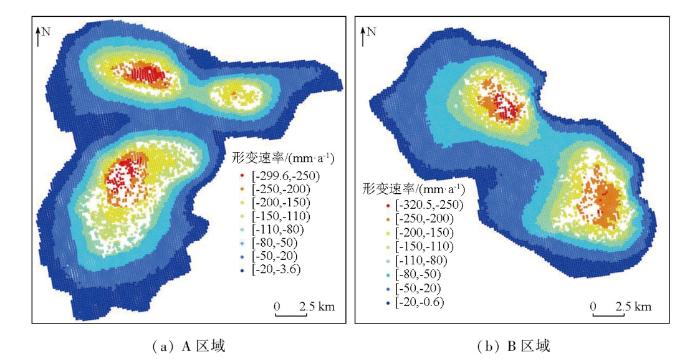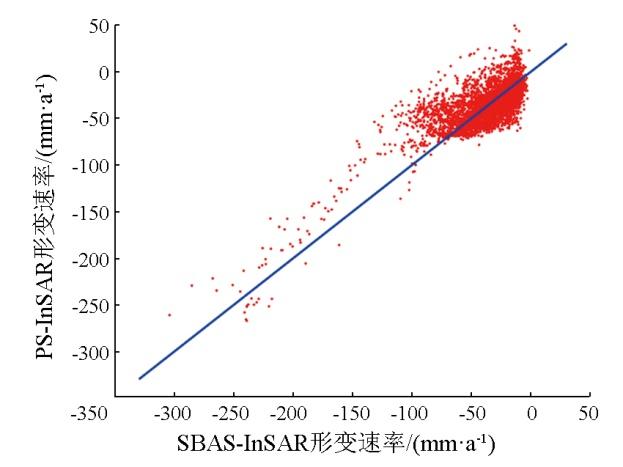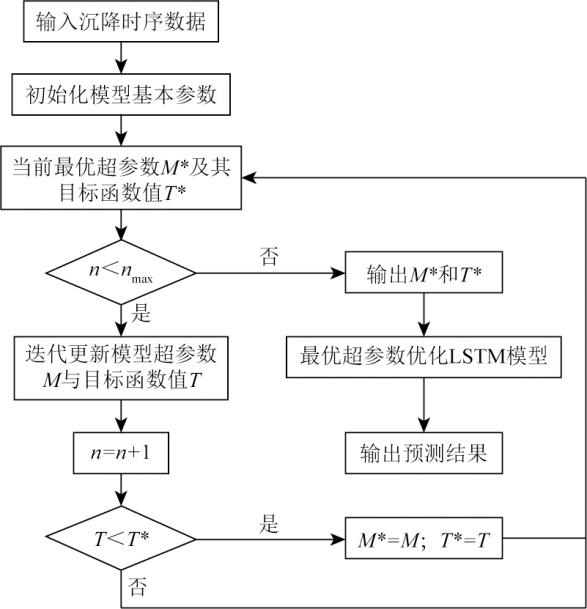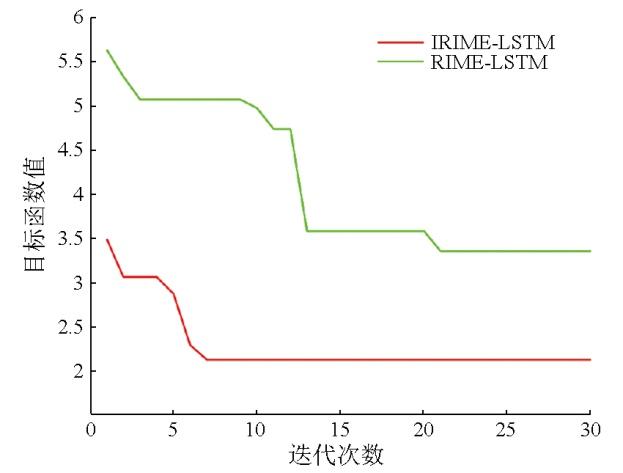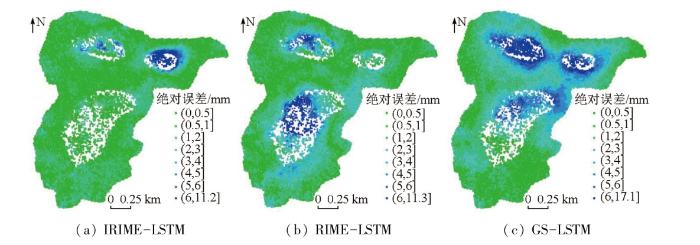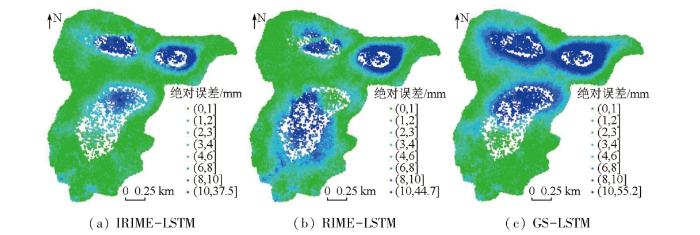0 引言
矿山开采导致的地表沉降是我国主要的地质灾害之一,给矿区带来破坏性影响[1 ] 。长期大规模的煤炭资源开发利用导致采空区周围岩体失去原来的平衡状态,诱发塌陷、滑坡等地质灾害并造成了严重的经济损失[2 ] 。因此,提前准确地预测矿区地表沉降对预防地质灾害至关重要。
目前传统的矿区沉降监测方法主要是使用仪器设备(如全站仪)获取地表的形变数据,但它们无法全面反映整个矿区的形变特征,并且存在成本高、效率低等缺点,还无法监测较为偏远的地方[3 -4 ] 。相较于传统的监测方法,利用干涉合成孔径雷达(interferometric synthetic aperture Radar, InSAR)技术监测矿区沉降,具有成本低、监测范围大的优势[5 -6 ] 。在InSAR技术的基础上,有学者提出差分干涉测量技术(differential interferometric synthetic aperture Radar, D-InSAR),实现在监测小梯度地表形变时达到高精度,但它的测量精度受到很多因素的影响,如影像的失相干、大气延迟等[7 ] 。小基线集干涉测量技术(small baseline subset InSAR, SBAS-InSAR)通过设置合适的时间和空间基线阈值,能更好地避免时空失相干,实现长时间序列的大范围微小形变监测[8 ] ,广泛应用地质灾害监测、矿区地表形变等领域。
地表沉降预测方法主要分为基于数理统计[9 ] 和基于机器学习[10 ] 2大类。基于数理统计的方法是通过回归分析、灰色模型等数理统计模型分析历史沉降数据自身的规律,实现地表沉降预测。但单一模型的预测精度较低,对非线性序列数据拟合性较差,周文韬等[11 ] 将差分整合移动平均自回归模型(autoregressive integrated moving average model, ARIMA)和Holt-Winters指数平滑模型组合起来进行预测,明显提升预测精度。基于机器学习的方法是通过计算机来学习沉降数据规律进行沉降拟合,该方法解决了传统数理统计方法难以准确模拟地表沉降的复杂非线性时序关系等问题。其中神经网络[12 ] 、支持向量机[13 ] 和极限学习机[14 ] 等,对复杂数据具有极高的拟合度,得到了广泛的应用。
近年来,深度学习作为一种新的机器学习方法,智能模拟人脑神经网络的结构和功能,具有强大的计算和数据分析能力,其中长短期时间记忆(long short-term memory, LSTM)网络模型通过“门”结构来改善梯度爆炸的问题,控制信息的保留程度,学习复杂的非线性时序数据[9 -10 ] 。然而,模型的超参数选取将直接影响其性能,主观选取超参数会使其效率低下,准确度不高。霜冰算法(rime optimization algorithm, RIME)[15 ] 具有解析快速和搜索能力强的优点,但在面对复杂优化问题时仍存在陷入局部最优和依赖初始解的问题。
本文引入混沌映射代替RIME算法的随机初始化,采用改进莱维飞行机制和猎食者算法(hunter-prey optimizer, HPO)[16 ] 的全局勘探策略来增强RIME算法的全局搜索能力和局部寻优能力,提出改进的霜冰算法(improved rime optimization algorithm, IRIME)对LSTM模型进行参数寻优,提高预测效率和准确度。以甘肃省红会煤矿为例,利用SBAS-InSAR技术获取高相干点的沉降时间序列,提出一种基于IRIME算法优化LSTM模型超参数的预测方法(IRIME-LSTM)对高相干点的沉降时序进行预测分析,为矿区地表沉降预测提供新思路。
1 研究方法
1.1 SBAS-InSAR技术
基于SBAS-InSAR技术对Sentinel-1A影像进行处理,根据研究区的范围对影像数据进行裁剪,设置合适的时间基线阈值和最大临界基线,对生成的影像对进行干涉处理和相位解缠; 移除相干性较差的影像对,对保留下来的影像对进行轨道精炼和重去平; 根据最小二乘法或奇异值分解法进行形变速率反演,得到研究区的年平均沉降速率和累积沉降时间序列。
1.2 LSTM模型
LSTM通过对每个细胞单元设计“门”结构来学习长期依赖关系以提高预测精度[10 ] ,其中“门”结构包括遗忘、输入和输出门。相关计算公式为:
(1) f t = σ ( W f · x t + W f · h t - 1 + b f ) i t = σ ( W i · x t + W i · h t - 1 + b i ) C t = f t · C t - 1 + i t k t k t = t a n h ( W k · x t + W k · h t - 1 + b k ) O t = σ ( W O · x t + W O · h t - 1 + b O ) , h t = O t · t a n h ( C t )
式中: t 为当前时刻; t -1为上一时刻; xt 为当前输入; kt 为t 时刻的临时记忆单元状态; σ 为激活函数sigmoid; ft ,it 和Ot 分别为遗忘、输入和输出门控; tanh 激活函数控制更新输入; W 和b 分别为对应门控的权重和偏置; C 和h 分别为记忆单元状态和隐含状态。
图1
图1
LSTM单元结构
Fig.1
Unite structure of LSTM
1.3 改进策略
RIME算法可提高模型的预测精度,但其通过概率分布来实现种群的初始化,全局搜索能力和局部寻优能力有限,因此引入混沌映射、改进莱维飞行机制和HPO算法的全局勘探策略提出IRIME算法,增强算法搜索能力,加快收敛速度,避免陷入局部最优。
1)混沌映射初始化种群。采用Bernoulli映射[17 ] 对种群进行初始化,使种群分布得更加均匀,增加个体的多样性,公式为:
(2) z m + 1 = z m 1 - λ , 0 < z m < 1 - λ z m - 1 + λ λ , 1 - λ < z m < 1
式中: zm 为产生的第m 代混沌序列的当前值; λ 为混沌影响因子,经过实验发现,当λ 处于0.5附近时能够获得更好的遍历性,取λ 为0.48。
2)改进莱维飞行机制。提高RIME算法在迭代后期跳出局部最优的能力,公式为:
(3) R ( n + 1 ) = ( 1 - P ) R ( n ) + γ · R B e s t + α ⊗ L e v y + r 1 c o s θ · β · ( h · ( U b + L b ) + L b )
(4) P = 2 · r a n d · ( 1 - n n m a x ) γ = e 1 - n m a x 1 - n + n m a x θ = π · n 10 · n m a x β = 1 - Q · n n m a x Q
(5) L e v y = u v 1 ε , u ~ N ( 0 , σ u 2 ) , v ~ N ( 0 , σ v 2 ) σ u = Γ ( 1 + ε ) · s i n ( π ε 2 ) ε · Γ ( 1 + ε 2 ) · 2 ε - 1 2 1 ε σ v = 1
式中: R (n )为霜冰粒子在当前迭代的位置; P 和γ 为比例系数; rand 生成[0,1 ]内的随机数; R Best 为全局最优位置; n 为当前迭代次数; n max 为最大迭代次数; α 为莱维飞行的步长缩放因子; $\otimes$为克罗内克积; Levy 为莱维飞行; Γ为伽玛函数; N 表示正态分布; σ 为标准差; r 1 为[-1,1]内的随机数; θ 和β 由当前迭代次数和最大迭代次数计算得到; h 为[0,1 ]内的随机数; U b 为搜索空间的上限; L b 为搜索空间的下限; u 和v 为正态分布随机数; ε 取值为1.5; Q 取值为5。
3)HPO算法的全局勘探策略。引入HPO算法更新霜冰粒子的位置,提高全局搜索能力,公式为:
(6) R n + 1 = R B e s t + D · E · c o s ( 2 π · r 2 ) · [ R B e s t - R ( n ) ]
式中: r 2 为[-1,1]内的随机数; D 为用于平衡探索和开发的参数,在迭代过程中逐渐减小; E 为自适应参数。
2 基于SBAS-InSAR的矿区地表沉降识别
2.1 研究区概况与数据来源
研究区红会煤矿位于甘肃省白银市平川区,矿区面积约为18.2 km2 ,经纬度范围为105°01'31″~105°04'23″E,36°38'30″~36°41'20″N。红会煤矿采用阶段斜井开拓方式,全井田共布置8个采区,主要对七、八采区进行开采,每年生产规模可达210万t。红会煤矿的可采煤层厚度在0.8~46.58 m之间,平均厚度13.94 m。煤层倾角一般小于25°,八采区煤层倾角较大,均超过25°,一般为30°~45°。煤层采厚比介于28.07~47.5之间,说明随着采掘工作面的推进,地面塌陷将持续发生。矿区属温带大陆性干旱气候,年平均气温为8.2 ℃,多年平均降雨量为250 mm。
本文数据来源为Sentinel-1A卫星,收集研究区2018年11月29日—2020年2月4日37景影像,监测周期为12 d,极化方式为VV极化,成像模式为IW。同时使用精密轨道文件和分辨率为30 m的SRTM数据去除轨道误差和地形相位的影响。
2.2 矿区地表沉降监测识别
基于SBAS-InSAR技术对37景影像进行处理,其数据处理流程如图2 所示。影像数据裁剪后,设置时间基线阈值为48 d,最大临界基线为2%。因本文对矿区垂向形变做研究分析,所以忽略地表南北向和东西向位移的影响,将视线向形变转至垂向形变,得到红会煤矿垂向年平均沉降速率和累积沉降时间序列,最终影像对的时空基线如图3 所示。实验结果表明,矿区内存在2处明显沉降区域,分别命名为A和B,各区域年平均沉降速率如图4 所示。其中,区域A是矿区内的最大沉降区域,且沉降也最严重,最大形变速率-299.6 mm/a,最大累计形变量为-353.2 mm; 矿区内最大形变速率发生在B区域,达-320.5 mm/a,最大累计形变量为-338.6 mm。由于论文篇幅所限,本文后续研究内容以区域A为研究对象,进行矿区地表沉降预测分析。
图2
图2
SBAS-InSAR数据处理流程
Fig.2
Flowchart of the SBAS InSAR data processing
图3
图3
最终的时空基线连接图
Fig.3
Final spatiotemporal baseline connection diagram
图4
图4
A和B区域形变速率
Fig.4
Subsidence rates in regions A and B
2.3 SBAS-InSAR可靠性分析
因缺乏红会煤矿同期水准监测数据,为验证SBAS-InSAR监测结果的可靠性,本文采用交叉验证法对SBAS-InSAR和PS-InSAR的同名高相干点(共5 041个)的年沉降速率进行对比分析[18 ] ,如图5 所示。由图5 可以看出SBAS-InSAR和PS-InSAR监测的年平均沉降速率具有较高的一致性,其相关系数为0.79。
图5
图5
SBAS-InSAR与PS-InSAR监测形变速率相关性
Fig.5
Correlation of subsidence rate of SBAS-InSAR and PS-InSAR monitoring
3 基于IRIME-LSTM模型的矿区地表沉降预测
3.1 IRIME-LSTM模型构建
LSTM网络模型中的样本长度L 影响地表沉降时序数据的输入,隐藏层节点数S 和网络层数K 影响神经网络的构建,初始学习率R 的取值影响网络模型的收敛,考虑到上述参数都对模型的预测精度有较大影响[19 21] ,因此使用IRIME算法进行参数寻优,以提升LSTM的预测效果,IRIME-LSTM大范围矿区地表沉降预测模型的流程如图6 所示。
图6
图6
IRIME-LSTM模型预测流程
Fig.6
IRIME-LSTM model prediction process
1)数据跨度大会影响模型的收敛速度和预测精度,输入高相干点的沉降时序数据,划分训练集和测试集,并进行归一化处理。公式为:
(7) x * = ( y m a x - y m i n ) × ( x - x m i n ) x m a x - x m i n + y m i n
式中: x 为原始沉降时序; x * 为归一化后的时序; x min 为原始沉降时序中的最小值; x max 为原始沉降时序中的最大值; 将数据集x 归一到区间[y min ,y max ],本文的y min 取-1,y max 取1。
2)初始化IRIME中的相关参数,包括种群数量,最大迭代次数,优化参数的取值范围等。
(8) m i n Z = 0.6 R M S E + 0.4 M A E
式中: minZ 为每个霜冰粒子的目标函数值; RMSE 为均方根误差; MAE 为平均绝对误差。根据Bernoulli映射生成种群的初始位置,计算每个霜冰粒子的目标函数值,得到初始化个体的最优解R Best ,即当前迭代的最优参数。
5)将得到的最优参数用于LSTM模型进行后续预测,得到预测结果。
3.2 IRIME-LSTM模型预测及分析
3.2.1 数据集预处理
利用SBAS-InSAR技术共提取37期矿区地表沉降时序数据,本研究共提取沉降区域A高相干点12 179个,将高相干点的前30期数据作为训练集,31~37期为测试集,并进行归一化处理。
3.2.2 模型性能评价指标
为评估网络模型的预测性能,选择均方根误差(root mean square error,RMSE)、平均绝对误差(mean absolute error,MAE)和平均绝对百分比误差(mean absolute percentage error,MAPE)为评价指标。计算公式为:
(9) R M S E = 1 N ∑ i = 1 N ( Y i p r e d - Y i ) 2
(10) M A E = 1 N ∑ i = 1 N Y i p r e d - Y i
(11) M A P E = 1 N ∑ i = 1 N Y i p r e d - Y i Y i × 100 %
式中: N 为高相干点数; Y i p r e d Yi 分别为第i 个高相干点的沉降预测值和InSAR监测值。
3.2.3 模型训练
使用IRIME算法对LSTM模型的初始学习率R 、隐藏层节点数S 、网络层数K 以及样本长度L 进行寻优,结合地表沉降时序数据,根据已有研究[19 -20 ] ,上述参数的取值范围分别设为[0.001,0.3],[1,100],[1,3]和[7,30],初步搭建IRIME-LSTM模型后,需对模型设置训练参数,本文模型训练参数如表1 。IRIME-LSTM模型的目标函数值变化如图7 所示,其对应的最优参数如表2 所示。
图7
图7
目标函数值变化
Fig.7
Changes in objective function value
3.2.4 最优LSTM模型预测
使用最优超参数用于LSTM模型进行后续预测,为对本文提出的算法进一步佐证,利用RIME算法和网格搜索算法(grid search, GS)对LSTM模型进行参数寻优,构建RIME-LSTM和GS-LSTM模型进行预测做对比分析。RIME-LSTM和GS-LSTM模型的训练参数与IRIME-LSTM模型相同,考虑到篇幅原因,本文仅展示不同模型单步预测和第7步预测的绝对误差空间分布(图8—9 ),各模型的性能评价指标变化趋势如图10 所示,单步预测和第7步预测的绝对误差具体分类及占比如表3—4 所示。
图8
图8
不同模型单步预测的绝对误差空间分布
Fig.8
Spatial distribution of absolute errors in single step prediction for different models
图9
图9
不同模型第7步预测的绝对误差空间分布
Fig.9
Spatial distribution of absolute errors in the seventh step of prediction for different models
图10
图10
不同模型的性能评价指标变化趋势
Fig.10
Trend of performance evaluation indicators for different models
由图8—10 以及表3—4 可知: IRIME-LSTM模型具有最佳预测效果,其单步预测的绝对误差低于2 mm的高相干点占比92.62%,第7步预测的绝对误差低于4 mm的高相干点占比83.25%; 整体测试集的RMSE 为2.65 mm,MAE 为1.59 mm,MAPE 为3.92%; RMSE 和MAE 在第5步预测之前的增长较为稳定,但在第5步之后增长速度突然加快; MAPE 在第2步预测呈现下降趋势,其余预测时期都为增长趋势,说明在应对长期预测时,预测效果没有短期预测那么理想。因工作面开采时间不一致,高相干点的沉降变化趋势不尽相同,所以图8(a) 中东北部的绝对误差较大。RIME-LSTM和GS-LSTM模型第7步预测的绝对误差低于4 mm的高相干点分别占比70.87%和60.48%; 整体测试集的RMSE 分别为4.22 mm和5.49 mm,MAE 分别为2.77 mm和3.64 mm,MAPE 分别为6.09%和7.92%。与对比模型相比,IRIME-LSTM模型整体测试集的RMSE 分别降低37.20%和51.73%,MAE 分别降低42.60%和56.32%,MAPE 分别降低35.63%和50.51%,表明IRIME-LSTM模型能更好地应对长期预测,其预测效果具有明显优势。
4 结论
本文以红会煤矿为研究对象,提出了一种融合SBAS-InSAR技术与IRIME-LSTM模型的矿区地表沉降预测方法,实现矿区的大范围监测,得出以下结论:
1)采用混沌映射、改进莱维飞行机制和HPO算法的全局勘探策略改进RIME算法,增强RIME算法的全局搜索能力和局部寻优能力,加快收敛速度,使用IRIME算法对LSTM模型进行超参数寻优,提高模型捕获地表沉降数据特征的能力。
2)IRIME-LSTM模型的精度指标均优于其他模型,表明该模型预测精度更高,具有较强的可靠性和可行性,为矿区地表沉降预测提供了一种新思路。
3)尽管所提预测模型能较好地实现矿区地表沉降预测,但考虑到矿区地表沉降与诸多因素有关,其预测效果依然存在一定的不足,后续研究中将影响因素纳入预测模型,以提高模型的适应性。
参考文献
View Option
[1]
李想 , 焦玉勇 , 邹俊鹏 , 等 . 深部采煤覆岩移动和地表沉降研究
[J]. 安全与环境工程 , 2022 , 29 (2 ):32 -38 ,56.
[本文引用: 3]
Li X Jiao Y Y Zou J P et al . Study on overlying strata movement and ground subsidence in deep coal mining
[J]. Safety and Environmental Engineering , 2022 , 29 (2 ):32 -38 ,56.
[本文引用: 3]
[2]
顿志林 , 王文唱 , 邹友峰 , 等 . 基于时间函数组合模型的采空区地表沉降动态预测及剩余变形计算
[J]. 煤炭学报 , 2022 , 47 (s1 ):13 -28 .
[本文引用: 1]
Dun Z L Wang W C Zou Y F et al . Dynamic prediction of surface subsidence and calculation of residual deformation in goaf based on time function combination model
[J]. Journal of China Coal Society , 2022 , 47 (s1 ):13 -28 .
[本文引用: 1]
[3]
徐子兴 , 季民 , 张过 , 等 . 基于SBAS-InSAR技术和Logistic模型的矿区沉降动态预测方法
[J]. 自然资源遥感 , 2022 , 34 (2 ):20 -29 .doi:10.6046/zrzyyg.2021354 .
[本文引用: 1]
Xu Z X Ji M Zhang G et al . Method for dynamic prediction of mining subsidence based on the SBAS-InSAR technology and the logistic model
[J]. Remote Sensing for Natural Resources , 2022 , 34 (2 ):20 -29 .doi:10.6046/zrzyyg.2021354 .
[本文引用: 1]
[4]
谭志祥 , 杨嘉威 , 邓喀中 . 基于SBAS-InSAR的矿区全盆地开采沉陷求参方法研究
[J]. 煤炭科学技术 , 2021 , 49 (1 ):312 -318 .
[本文引用: 1]
Tan Z X Yang J W Deng K Z Study on method of mining subsi-dence parameters calculating for whole basin of mining area based on SBAS-InSAR
[J]. Coal Science and Technology , 2021 , 49 (1 ):312 -318 .
[本文引用: 1]
[5]
[本文引用: 1]
Yang W He Y Zhang L F et al . InSAR monitoring of 3D surface deformation in Jinchuan mining area,Gansu Province
[J]. Remote Sensing for Natural Resources , 2022 , 34 (1 ):177 -188 .doi:10.6046/zrzyyg.2021107 .
[本文引用: 1]
[6]
Riyas M J Syed T H Kumar H et al . Detecting and analyzing the evolution of subsidence due to coal fires in Jharia coalfield,India using sentinel-1 SAR data
[J]. Remote Sensing , 2021 , 13 (8 ):1521 .
[本文引用: 1]
[7]
麻源源 , 陈云波 , 左小清 , 等 . Sentinel-1A数据及短基线集的昆明地面沉降分析
[J]. 测绘科学 , 2019 , 44 (11 ):59 -66 ,95.
[本文引用: 1]
Ma Y Y Chen Y B Zuo X Q et al . Analysis of land subsidence in Kunming based on Sentinel-1A data and SBAS technology
[J]. Science of Surveying and Mapping , 2019 , 44 (11 ):59 -66 ,95.
[本文引用: 1]
[8]
Ding Y K Liu R Fan Y F et al . Monitoring glaciers in the Chenab Basin with SBAS InSAR technology
[J]. Journal of Mountain Science , 2022 , 19 (9 ):2622 -2633 .
[本文引用: 1]
[9]
杨帆 , 胡晋 , 孙彩霞 . InSAR技术结合深度学习的范围性地表沉降预测
[J]. 测绘科学 , 2022 , 47 (7 ):60 -68 ,134.
[本文引用: 2]
Yang F Hu J Sun C X Prediction of range surface subsidence based on InSAR technology and deep learning
[J]. Science of Surveying and Mapping , 2022 , 47 (7 ):60 -68 ,134.
[本文引用: 2]
[10]
刘青豪 , 张永红 , 邓敏 , 等 . 大范围地表沉降时序深度学习预测法
[J]. 测绘学报 , 2021 , 50 (3 ):396 -404 .
DOI:10.11947/j.AGCS.2021.20200038
[本文引用: 3]
地表沉降不仅影响社会经济的可持续发展,还威胁人类的生命安全。高精度的地表沉降预测对人类预防地质灾害具有重要意义。现有的预测方法因模型参数难以获取或相关数据的缺乏而难以得到可靠的预测结果,针对此问题,本文提出一种基于深度学习的地表沉降预测方法。首先采用多主影像相干目标小基线干涉技术MCTSB-InSAR获取大区域高精度地表形变时序反演结果;其次利用循环神经网络作为网络架构,用长短期记忆(LSTM)模型进行地表沉降特征学习;最后采用网格搜索的方法调整模型参数,进而获取最优的模型参数组合方案。实际观测结果显示,相较于现有地表沉降预测方法,本文提出的预测模型平均绝对误差(0.3 mm)至少降低了27.3%,差分沉降量平均预测精度至少提高了8.9%。空间格局分析的结果表明,LSTM模型对于大区域时序形变的短期预测是有效的。
Liu Q H Zhang Y H Deng M et al . Time series prediction method of large-scale surface subsidence based on deep learning
[J]. Acta Geodaetica et Cartographica Sinica , 2021 , 50 (3 ):396 -404 .
DOI:10.11947/j.AGCS.2021.20200038
[本文引用: 3]
Surface subsidence not only affects the sustainable development of social economy, but also threatens the safety of human life. High precision prediction of surface subsidence is of great significance for the prevention of geological disasters. However, the existing prediction methods are difficult to obtain reliable prediction results because of the model parameters or the lack of relevant data. For this problem, a method of surface subsidence prediction based on deep learning is proposed. Firstly, the multiple master-image coherent target small-baseline InSAR (MCTSB-InSAR) is used to obtain the inversion results of large area and high precision ground deformation time series. Secondly, the cyclic neural network is used as the network framework, and the long short-term memory (LSTM) model is used to learn the characteristics of ground settlement. Finally, the grid search method is used to adjust the model parameters, then get the optimal combination scheme of model parameters. The actual observation results show that the average absolute error (0.3 mm) of the prediction model proposed in this paper is reduced by 27.3% at least, and the average prediction accuracy of differential settlement is improved by 8.9% at least. The results of spatial pattern analysis show that the LSTM model is effective for the short-term prediction of large-scale time series deformation.
[11]
周文韬 , 张文君 , 杨元继 , 等 . 矿区地表沉降监测的一种组合模型预测方法
[J]. 大地测量与地球动力学 , 2021 , 41 (3 ):308 -312 .
[本文引用: 1]
Zhou W T Zhang W J Yang Y J et al . A combined model prediction method for surface subsidence monitoring in mining areas
[J]. Journal of Geodesy and Geodynamics , 2021 , 41 (3 ):308 -312 .
[本文引用: 1]
[12]
岳振华 , 沈涛 , 毛曦 , 等 . 循环神经网络的地面沉降预测方法
[J]. 测绘科学 , 2020 , 45 (12 ):145 -152 .
[本文引用: 1]
Yue Z H Shen T Mao X et al . Study on prediction method of land subsidence based on recurrent neural network
[J]. Science of Surveying and Mapping , 2020 , 45 (12 ):145 -152 .
[本文引用: 1]
[13]
师芸 , 李杰 , 吕杰 , 等 . 结合SBAS-InSAR与支持向量回归的开采沉陷监测与预测
[J]. 遥感信息 , 2021 , 36 (2 ):6 -12 .
[本文引用: 1]
Shi Y Li J Lyv J et al . Monitoring and prediction of mining subsidence based on SBAS-InSAR and improved support vector regression
[J]. Remote Sensing Information , 2021 , 36 (2 ):6 -12 .
[本文引用: 1]
[14]
鄢涛 , 陈波 , 曹恩华 , 等 . 基于EEMD-ELM的大坝变形预测模型
[J]. 长江科学院院报 , 2020 , 37 (11 ):70 -73 ,80.
[本文引用: 1]
Yan T Chen B Cao E H et al . Prediction of dam deformation using EEMD-ELM model
[J]. Journal of Yangtze River Scientific Research Institute , 2020 , 37 (11 ):70 -73 ,80.
DOI:10.11988/ckyyb.20190892
[本文引用: 1]
A reasonable and credible dam deformation monitoring model is of great significance for scientific and effective analysis of dam deformation monitoring data and accurate and reliable evaluation of dam's working and operating conditions. The EEMD (Ensemble Empirical Mode Decomposition) model is adopted to decompose the dam deformation monitoring data, and the IMF (Intrinsic Mode Function) components representing different feature scales are obtained. With different influence factors for different components, the IMF components are used as the training samples of ELM (Extreme Learning Machine) to analyze, fit and predict the monitoring data. The predicted values of dam deformation are obtained by adding the values of each component. With a RCC (Roller Compacted Concrete) gravity dam as an example, the prediction result of EEMD-ELM model is compared with those of BPNN (Back Propagation Neural Network) model and ELM model. The comparison result reveal that the prediction accuracy of EEMD-ELM model is higher than that of BPNN model and ELM model, with the mean relative error merely 0.566, 54% and 14.8% lower than those of BPNN and ELM, respectively.
[15]
Su H Zhao D Heidari A A et al . RIME:A physics-based optimization
[J]. Neurocomputing , 2023 ,532:183 -214 .
[本文引用: 1]
[16]
Wang X Li J Shao L et al . Short-term wind power prediction by an extreme learning machine based on an improved hunter-prey optimization algorithm
[J]. Sustainability , 2023 , 15 (2 ):991 .
[本文引用: 1]
[17]
葛唱 , 钱素琴 . 改进麻雀搜索算法的无人车路径规划
[J]. 导航定位学报 , 2022 , 10 (6 ):107 -111 .
[本文引用: 1]
Ge C Qian S Q Path planning of unmanned vehicle based on improved sparrow search algorithm
[J]. Journal of Navigation and Positioning , 2022 , 10 (6 ):107 -111 .
[本文引用: 1]
[18]
[本文引用: 1]
Liu H Xu X Y Chen M et al . Time-series InSAR-based dynamic remote sensing monitoring of the Great Wall of the Ming Dynasty in Qinhuangdao
[J]. Remote Sensing for Natural Resources , 2023 , 35 (2 ):202 -211 .doi:10.6046/zrzyyg.2021163 .
[本文引用: 1]
[19]
肖海平 , 夏益强 , 刘小生 , 等 . 融合SBAS-InSAR技术与TSO-LSTM模型的矿区地表沉降预测方法
[J]. 金属矿山 , 2023 (1 ):126 -133 .
[本文引用: 2]
Xiao H P Xia Y Q Liu X S et al . Prediction method of surface subsidence in mining area by the integration of SBAS-InSAR technique and TSO-LSTM model
[J]. Metal Mine , 2023 (1 ):126 -133 .
[本文引用: 2]
[20]
刘青豪 , 刘慧敏 , 张永红 , 等 . 顾及空间异质性的大范围地面沉降时空预测
[J]. 遥感学报 , 2022 , 26 (7 ):1315 -1325 .
[本文引用: 1]
Liu Q H Liu H M Zhang Y H et al . A spatio-temporal prediction method of large-scale ground subsidence considering spatial hete-rogeneity
[J]. National Remote Sensing Bulletin , 2022 , 26 (7 ):1315 -1325 .
[本文引用: 1]
[21]
刘宝宝 , 杨菁菁 , 陶露 , 等 . 基于DE-LSTM模型的教育统计数据预测研究
[J]. 计算机科学 , 2022 , 49 (s1 ):261 -266 .
[本文引用: 1]
Liu B B Yang J J Tao L et al . Study on prediction of educational statistical data based on DE-LSTM model
[J]. Computer Science , 2022 , 49 (s1 ):261 -266 .
[本文引用: 1]
深部采煤覆岩移动和地表沉降研究
3
2022
... 矿山开采导致的地表沉降是我国主要的地质灾害之一,给矿区带来破坏性影响[1 ] .长期大规模的煤炭资源开发利用导致采空区周围岩体失去原来的平衡状态,诱发塌陷、滑坡等地质灾害并造成了严重的经济损失[2 ] .因此,提前准确地预测矿区地表沉降对预防地质灾害至关重要. ...
... 式中: R (n )为霜冰粒子在当前迭代的位置; P 和γ 为比例系数; rand 生成[0,1 ]内的随机数; R Best 为全局最优位置; n 为当前迭代次数; n max 为最大迭代次数; α 为莱维飞行的步长缩放因子; $\otimes$为克罗内克积; Levy 为莱维飞行; Γ为伽玛函数; N 表示正态分布; σ 为标准差; r 1 为[-1,1]内的随机数; θ 和β 由当前迭代次数和最大迭代次数计算得到; h 为[0,1 ]内的随机数; U b 为搜索空间的上限; L b 为搜索空间的下限; u 和v 为正态分布随机数; ε 取值为1.5; Q 取值为5. ...
... 为[0,1 ]内的随机数; U b 为搜索空间的上限; L b 为搜索空间的下限; u 和v 为正态分布随机数; ε 取值为1.5; Q 取值为5. ...
深部采煤覆岩移动和地表沉降研究
3
2022
... 矿山开采导致的地表沉降是我国主要的地质灾害之一,给矿区带来破坏性影响[1 ] .长期大规模的煤炭资源开发利用导致采空区周围岩体失去原来的平衡状态,诱发塌陷、滑坡等地质灾害并造成了严重的经济损失[2 ] .因此,提前准确地预测矿区地表沉降对预防地质灾害至关重要. ...
... 式中: R (n )为霜冰粒子在当前迭代的位置; P 和γ 为比例系数; rand 生成[0,1 ]内的随机数; R Best 为全局最优位置; n 为当前迭代次数; n max 为最大迭代次数; α 为莱维飞行的步长缩放因子; $\otimes$为克罗内克积; Levy 为莱维飞行; Γ为伽玛函数; N 表示正态分布; σ 为标准差; r 1 为[-1,1]内的随机数; θ 和β 由当前迭代次数和最大迭代次数计算得到; h 为[0,1 ]内的随机数; U b 为搜索空间的上限; L b 为搜索空间的下限; u 和v 为正态分布随机数; ε 取值为1.5; Q 取值为5. ...
... 为[0,1 ]内的随机数; U b 为搜索空间的上限; L b 为搜索空间的下限; u 和v 为正态分布随机数; ε 取值为1.5; Q 取值为5. ...
基于时间函数组合模型的采空区地表沉降动态预测及剩余变形计算
1
2022
... 矿山开采导致的地表沉降是我国主要的地质灾害之一,给矿区带来破坏性影响[1 ] .长期大规模的煤炭资源开发利用导致采空区周围岩体失去原来的平衡状态,诱发塌陷、滑坡等地质灾害并造成了严重的经济损失[2 ] .因此,提前准确地预测矿区地表沉降对预防地质灾害至关重要. ...
基于时间函数组合模型的采空区地表沉降动态预测及剩余变形计算
1
2022
... 矿山开采导致的地表沉降是我国主要的地质灾害之一,给矿区带来破坏性影响[1 ] .长期大规模的煤炭资源开发利用导致采空区周围岩体失去原来的平衡状态,诱发塌陷、滑坡等地质灾害并造成了严重的经济损失[2 ] .因此,提前准确地预测矿区地表沉降对预防地质灾害至关重要. ...
基于SBAS-InSAR技术和Logistic模型的矿区沉降动态预测方法
1
2022
... 目前传统的矿区沉降监测方法主要是使用仪器设备(如全站仪)获取地表的形变数据,但它们无法全面反映整个矿区的形变特征,并且存在成本高、效率低等缺点,还无法监测较为偏远的地方[3 -4 ] .相较于传统的监测方法,利用干涉合成孔径雷达(interferometric synthetic aperture Radar, InSAR)技术监测矿区沉降,具有成本低、监测范围大的优势[5 -6 ] .在InSAR技术的基础上,有学者提出差分干涉测量技术(differential interferometric synthetic aperture Radar, D-InSAR),实现在监测小梯度地表形变时达到高精度,但它的测量精度受到很多因素的影响,如影像的失相干、大气延迟等[7 ] .小基线集干涉测量技术(small baseline subset InSAR, SBAS-InSAR)通过设置合适的时间和空间基线阈值,能更好地避免时空失相干,实现长时间序列的大范围微小形变监测[8 ] ,广泛应用地质灾害监测、矿区地表形变等领域. ...
基于SBAS-InSAR技术和Logistic模型的矿区沉降动态预测方法
1
2022
... 目前传统的矿区沉降监测方法主要是使用仪器设备(如全站仪)获取地表的形变数据,但它们无法全面反映整个矿区的形变特征,并且存在成本高、效率低等缺点,还无法监测较为偏远的地方[3 -4 ] .相较于传统的监测方法,利用干涉合成孔径雷达(interferometric synthetic aperture Radar, InSAR)技术监测矿区沉降,具有成本低、监测范围大的优势[5 -6 ] .在InSAR技术的基础上,有学者提出差分干涉测量技术(differential interferometric synthetic aperture Radar, D-InSAR),实现在监测小梯度地表形变时达到高精度,但它的测量精度受到很多因素的影响,如影像的失相干、大气延迟等[7 ] .小基线集干涉测量技术(small baseline subset InSAR, SBAS-InSAR)通过设置合适的时间和空间基线阈值,能更好地避免时空失相干,实现长时间序列的大范围微小形变监测[8 ] ,广泛应用地质灾害监测、矿区地表形变等领域. ...
基于SBAS-InSAR的矿区全盆地开采沉陷求参方法研究
1
2021
... 目前传统的矿区沉降监测方法主要是使用仪器设备(如全站仪)获取地表的形变数据,但它们无法全面反映整个矿区的形变特征,并且存在成本高、效率低等缺点,还无法监测较为偏远的地方[3 -4 ] .相较于传统的监测方法,利用干涉合成孔径雷达(interferometric synthetic aperture Radar, InSAR)技术监测矿区沉降,具有成本低、监测范围大的优势[5 -6 ] .在InSAR技术的基础上,有学者提出差分干涉测量技术(differential interferometric synthetic aperture Radar, D-InSAR),实现在监测小梯度地表形变时达到高精度,但它的测量精度受到很多因素的影响,如影像的失相干、大气延迟等[7 ] .小基线集干涉测量技术(small baseline subset InSAR, SBAS-InSAR)通过设置合适的时间和空间基线阈值,能更好地避免时空失相干,实现长时间序列的大范围微小形变监测[8 ] ,广泛应用地质灾害监测、矿区地表形变等领域. ...
基于SBAS-InSAR的矿区全盆地开采沉陷求参方法研究
1
2021
... 目前传统的矿区沉降监测方法主要是使用仪器设备(如全站仪)获取地表的形变数据,但它们无法全面反映整个矿区的形变特征,并且存在成本高、效率低等缺点,还无法监测较为偏远的地方[3 -4 ] .相较于传统的监测方法,利用干涉合成孔径雷达(interferometric synthetic aperture Radar, InSAR)技术监测矿区沉降,具有成本低、监测范围大的优势[5 -6 ] .在InSAR技术的基础上,有学者提出差分干涉测量技术(differential interferometric synthetic aperture Radar, D-InSAR),实现在监测小梯度地表形变时达到高精度,但它的测量精度受到很多因素的影响,如影像的失相干、大气延迟等[7 ] .小基线集干涉测量技术(small baseline subset InSAR, SBAS-InSAR)通过设置合适的时间和空间基线阈值,能更好地避免时空失相干,实现长时间序列的大范围微小形变监测[8 ] ,广泛应用地质灾害监测、矿区地表形变等领域. ...
甘肃金川矿区地表三维形变InSAR监测
1
2022
... 目前传统的矿区沉降监测方法主要是使用仪器设备(如全站仪)获取地表的形变数据,但它们无法全面反映整个矿区的形变特征,并且存在成本高、效率低等缺点,还无法监测较为偏远的地方[3 -4 ] .相较于传统的监测方法,利用干涉合成孔径雷达(interferometric synthetic aperture Radar, InSAR)技术监测矿区沉降,具有成本低、监测范围大的优势[5 -6 ] .在InSAR技术的基础上,有学者提出差分干涉测量技术(differential interferometric synthetic aperture Radar, D-InSAR),实现在监测小梯度地表形变时达到高精度,但它的测量精度受到很多因素的影响,如影像的失相干、大气延迟等[7 ] .小基线集干涉测量技术(small baseline subset InSAR, SBAS-InSAR)通过设置合适的时间和空间基线阈值,能更好地避免时空失相干,实现长时间序列的大范围微小形变监测[8 ] ,广泛应用地质灾害监测、矿区地表形变等领域. ...
甘肃金川矿区地表三维形变InSAR监测
1
2022
... 目前传统的矿区沉降监测方法主要是使用仪器设备(如全站仪)获取地表的形变数据,但它们无法全面反映整个矿区的形变特征,并且存在成本高、效率低等缺点,还无法监测较为偏远的地方[3 -4 ] .相较于传统的监测方法,利用干涉合成孔径雷达(interferometric synthetic aperture Radar, InSAR)技术监测矿区沉降,具有成本低、监测范围大的优势[5 -6 ] .在InSAR技术的基础上,有学者提出差分干涉测量技术(differential interferometric synthetic aperture Radar, D-InSAR),实现在监测小梯度地表形变时达到高精度,但它的测量精度受到很多因素的影响,如影像的失相干、大气延迟等[7 ] .小基线集干涉测量技术(small baseline subset InSAR, SBAS-InSAR)通过设置合适的时间和空间基线阈值,能更好地避免时空失相干,实现长时间序列的大范围微小形变监测[8 ] ,广泛应用地质灾害监测、矿区地表形变等领域. ...
Detecting and analyzing the evolution of subsidence due to coal fires in Jharia coalfield,India using sentinel-1 SAR data
1
2021
... 目前传统的矿区沉降监测方法主要是使用仪器设备(如全站仪)获取地表的形变数据,但它们无法全面反映整个矿区的形变特征,并且存在成本高、效率低等缺点,还无法监测较为偏远的地方[3 -4 ] .相较于传统的监测方法,利用干涉合成孔径雷达(interferometric synthetic aperture Radar, InSAR)技术监测矿区沉降,具有成本低、监测范围大的优势[5 -6 ] .在InSAR技术的基础上,有学者提出差分干涉测量技术(differential interferometric synthetic aperture Radar, D-InSAR),实现在监测小梯度地表形变时达到高精度,但它的测量精度受到很多因素的影响,如影像的失相干、大气延迟等[7 ] .小基线集干涉测量技术(small baseline subset InSAR, SBAS-InSAR)通过设置合适的时间和空间基线阈值,能更好地避免时空失相干,实现长时间序列的大范围微小形变监测[8 ] ,广泛应用地质灾害监测、矿区地表形变等领域. ...
Sentinel-1A数据及短基线集的昆明地面沉降分析
1
2019
... 目前传统的矿区沉降监测方法主要是使用仪器设备(如全站仪)获取地表的形变数据,但它们无法全面反映整个矿区的形变特征,并且存在成本高、效率低等缺点,还无法监测较为偏远的地方[3 -4 ] .相较于传统的监测方法,利用干涉合成孔径雷达(interferometric synthetic aperture Radar, InSAR)技术监测矿区沉降,具有成本低、监测范围大的优势[5 -6 ] .在InSAR技术的基础上,有学者提出差分干涉测量技术(differential interferometric synthetic aperture Radar, D-InSAR),实现在监测小梯度地表形变时达到高精度,但它的测量精度受到很多因素的影响,如影像的失相干、大气延迟等[7 ] .小基线集干涉测量技术(small baseline subset InSAR, SBAS-InSAR)通过设置合适的时间和空间基线阈值,能更好地避免时空失相干,实现长时间序列的大范围微小形变监测[8 ] ,广泛应用地质灾害监测、矿区地表形变等领域. ...
Sentinel-1A数据及短基线集的昆明地面沉降分析
1
2019
... 目前传统的矿区沉降监测方法主要是使用仪器设备(如全站仪)获取地表的形变数据,但它们无法全面反映整个矿区的形变特征,并且存在成本高、效率低等缺点,还无法监测较为偏远的地方[3 -4 ] .相较于传统的监测方法,利用干涉合成孔径雷达(interferometric synthetic aperture Radar, InSAR)技术监测矿区沉降,具有成本低、监测范围大的优势[5 -6 ] .在InSAR技术的基础上,有学者提出差分干涉测量技术(differential interferometric synthetic aperture Radar, D-InSAR),实现在监测小梯度地表形变时达到高精度,但它的测量精度受到很多因素的影响,如影像的失相干、大气延迟等[7 ] .小基线集干涉测量技术(small baseline subset InSAR, SBAS-InSAR)通过设置合适的时间和空间基线阈值,能更好地避免时空失相干,实现长时间序列的大范围微小形变监测[8 ] ,广泛应用地质灾害监测、矿区地表形变等领域. ...
Monitoring glaciers in the Chenab Basin with SBAS InSAR technology
1
2022
... 目前传统的矿区沉降监测方法主要是使用仪器设备(如全站仪)获取地表的形变数据,但它们无法全面反映整个矿区的形变特征,并且存在成本高、效率低等缺点,还无法监测较为偏远的地方[3 -4 ] .相较于传统的监测方法,利用干涉合成孔径雷达(interferometric synthetic aperture Radar, InSAR)技术监测矿区沉降,具有成本低、监测范围大的优势[5 -6 ] .在InSAR技术的基础上,有学者提出差分干涉测量技术(differential interferometric synthetic aperture Radar, D-InSAR),实现在监测小梯度地表形变时达到高精度,但它的测量精度受到很多因素的影响,如影像的失相干、大气延迟等[7 ] .小基线集干涉测量技术(small baseline subset InSAR, SBAS-InSAR)通过设置合适的时间和空间基线阈值,能更好地避免时空失相干,实现长时间序列的大范围微小形变监测[8 ] ,广泛应用地质灾害监测、矿区地表形变等领域. ...
InSAR技术结合深度学习的范围性地表沉降预测
2
2022
... 地表沉降预测方法主要分为基于数理统计[9 ] 和基于机器学习[10 ] 2大类.基于数理统计的方法是通过回归分析、灰色模型等数理统计模型分析历史沉降数据自身的规律,实现地表沉降预测.但单一模型的预测精度较低,对非线性序列数据拟合性较差,周文韬等[11 ] 将差分整合移动平均自回归模型(autoregressive integrated moving average model, ARIMA)和Holt-Winters指数平滑模型组合起来进行预测,明显提升预测精度.基于机器学习的方法是通过计算机来学习沉降数据规律进行沉降拟合,该方法解决了传统数理统计方法难以准确模拟地表沉降的复杂非线性时序关系等问题.其中神经网络[12 ] 、支持向量机[13 ] 和极限学习机[14 ] 等,对复杂数据具有极高的拟合度,得到了广泛的应用. ...
... 近年来,深度学习作为一种新的机器学习方法,智能模拟人脑神经网络的结构和功能,具有强大的计算和数据分析能力,其中长短期时间记忆(long short-term memory, LSTM)网络模型通过“门”结构来改善梯度爆炸的问题,控制信息的保留程度,学习复杂的非线性时序数据[9 -10 ] .然而,模型的超参数选取将直接影响其性能,主观选取超参数会使其效率低下,准确度不高.霜冰算法(rime optimization algorithm, RIME)[15 ] 具有解析快速和搜索能力强的优点,但在面对复杂优化问题时仍存在陷入局部最优和依赖初始解的问题. ...
InSAR技术结合深度学习的范围性地表沉降预测
2
2022
... 地表沉降预测方法主要分为基于数理统计[9 ] 和基于机器学习[10 ] 2大类.基于数理统计的方法是通过回归分析、灰色模型等数理统计模型分析历史沉降数据自身的规律,实现地表沉降预测.但单一模型的预测精度较低,对非线性序列数据拟合性较差,周文韬等[11 ] 将差分整合移动平均自回归模型(autoregressive integrated moving average model, ARIMA)和Holt-Winters指数平滑模型组合起来进行预测,明显提升预测精度.基于机器学习的方法是通过计算机来学习沉降数据规律进行沉降拟合,该方法解决了传统数理统计方法难以准确模拟地表沉降的复杂非线性时序关系等问题.其中神经网络[12 ] 、支持向量机[13 ] 和极限学习机[14 ] 等,对复杂数据具有极高的拟合度,得到了广泛的应用. ...
... 近年来,深度学习作为一种新的机器学习方法,智能模拟人脑神经网络的结构和功能,具有强大的计算和数据分析能力,其中长短期时间记忆(long short-term memory, LSTM)网络模型通过“门”结构来改善梯度爆炸的问题,控制信息的保留程度,学习复杂的非线性时序数据[9 -10 ] .然而,模型的超参数选取将直接影响其性能,主观选取超参数会使其效率低下,准确度不高.霜冰算法(rime optimization algorithm, RIME)[15 ] 具有解析快速和搜索能力强的优点,但在面对复杂优化问题时仍存在陷入局部最优和依赖初始解的问题. ...
大范围地表沉降时序深度学习预测法
3
2021
... 地表沉降预测方法主要分为基于数理统计[9 ] 和基于机器学习[10 ] 2大类.基于数理统计的方法是通过回归分析、灰色模型等数理统计模型分析历史沉降数据自身的规律,实现地表沉降预测.但单一模型的预测精度较低,对非线性序列数据拟合性较差,周文韬等[11 ] 将差分整合移动平均自回归模型(autoregressive integrated moving average model, ARIMA)和Holt-Winters指数平滑模型组合起来进行预测,明显提升预测精度.基于机器学习的方法是通过计算机来学习沉降数据规律进行沉降拟合,该方法解决了传统数理统计方法难以准确模拟地表沉降的复杂非线性时序关系等问题.其中神经网络[12 ] 、支持向量机[13 ] 和极限学习机[14 ] 等,对复杂数据具有极高的拟合度,得到了广泛的应用. ...
... 近年来,深度学习作为一种新的机器学习方法,智能模拟人脑神经网络的结构和功能,具有强大的计算和数据分析能力,其中长短期时间记忆(long short-term memory, LSTM)网络模型通过“门”结构来改善梯度爆炸的问题,控制信息的保留程度,学习复杂的非线性时序数据[9 -10 ] .然而,模型的超参数选取将直接影响其性能,主观选取超参数会使其效率低下,准确度不高.霜冰算法(rime optimization algorithm, RIME)[15 ] 具有解析快速和搜索能力强的优点,但在面对复杂优化问题时仍存在陷入局部最优和依赖初始解的问题. ...
... LSTM通过对每个细胞单元设计“门”结构来学习长期依赖关系以提高预测精度[10 ] ,其中“门”结构包括遗忘、输入和输出门.相关计算公式为: ...
大范围地表沉降时序深度学习预测法
3
2021
... 地表沉降预测方法主要分为基于数理统计[9 ] 和基于机器学习[10 ] 2大类.基于数理统计的方法是通过回归分析、灰色模型等数理统计模型分析历史沉降数据自身的规律,实现地表沉降预测.但单一模型的预测精度较低,对非线性序列数据拟合性较差,周文韬等[11 ] 将差分整合移动平均自回归模型(autoregressive integrated moving average model, ARIMA)和Holt-Winters指数平滑模型组合起来进行预测,明显提升预测精度.基于机器学习的方法是通过计算机来学习沉降数据规律进行沉降拟合,该方法解决了传统数理统计方法难以准确模拟地表沉降的复杂非线性时序关系等问题.其中神经网络[12 ] 、支持向量机[13 ] 和极限学习机[14 ] 等,对复杂数据具有极高的拟合度,得到了广泛的应用. ...
... 近年来,深度学习作为一种新的机器学习方法,智能模拟人脑神经网络的结构和功能,具有强大的计算和数据分析能力,其中长短期时间记忆(long short-term memory, LSTM)网络模型通过“门”结构来改善梯度爆炸的问题,控制信息的保留程度,学习复杂的非线性时序数据[9 -10 ] .然而,模型的超参数选取将直接影响其性能,主观选取超参数会使其效率低下,准确度不高.霜冰算法(rime optimization algorithm, RIME)[15 ] 具有解析快速和搜索能力强的优点,但在面对复杂优化问题时仍存在陷入局部最优和依赖初始解的问题. ...
... LSTM通过对每个细胞单元设计“门”结构来学习长期依赖关系以提高预测精度[10 ] ,其中“门”结构包括遗忘、输入和输出门.相关计算公式为: ...
矿区地表沉降监测的一种组合模型预测方法
1
2021
... 地表沉降预测方法主要分为基于数理统计[9 ] 和基于机器学习[10 ] 2大类.基于数理统计的方法是通过回归分析、灰色模型等数理统计模型分析历史沉降数据自身的规律,实现地表沉降预测.但单一模型的预测精度较低,对非线性序列数据拟合性较差,周文韬等[11 ] 将差分整合移动平均自回归模型(autoregressive integrated moving average model, ARIMA)和Holt-Winters指数平滑模型组合起来进行预测,明显提升预测精度.基于机器学习的方法是通过计算机来学习沉降数据规律进行沉降拟合,该方法解决了传统数理统计方法难以准确模拟地表沉降的复杂非线性时序关系等问题.其中神经网络[12 ] 、支持向量机[13 ] 和极限学习机[14 ] 等,对复杂数据具有极高的拟合度,得到了广泛的应用. ...
矿区地表沉降监测的一种组合模型预测方法
1
2021
... 地表沉降预测方法主要分为基于数理统计[9 ] 和基于机器学习[10 ] 2大类.基于数理统计的方法是通过回归分析、灰色模型等数理统计模型分析历史沉降数据自身的规律,实现地表沉降预测.但单一模型的预测精度较低,对非线性序列数据拟合性较差,周文韬等[11 ] 将差分整合移动平均自回归模型(autoregressive integrated moving average model, ARIMA)和Holt-Winters指数平滑模型组合起来进行预测,明显提升预测精度.基于机器学习的方法是通过计算机来学习沉降数据规律进行沉降拟合,该方法解决了传统数理统计方法难以准确模拟地表沉降的复杂非线性时序关系等问题.其中神经网络[12 ] 、支持向量机[13 ] 和极限学习机[14 ] 等,对复杂数据具有极高的拟合度,得到了广泛的应用. ...
循环神经网络的地面沉降预测方法
1
2020
... 地表沉降预测方法主要分为基于数理统计[9 ] 和基于机器学习[10 ] 2大类.基于数理统计的方法是通过回归分析、灰色模型等数理统计模型分析历史沉降数据自身的规律,实现地表沉降预测.但单一模型的预测精度较低,对非线性序列数据拟合性较差,周文韬等[11 ] 将差分整合移动平均自回归模型(autoregressive integrated moving average model, ARIMA)和Holt-Winters指数平滑模型组合起来进行预测,明显提升预测精度.基于机器学习的方法是通过计算机来学习沉降数据规律进行沉降拟合,该方法解决了传统数理统计方法难以准确模拟地表沉降的复杂非线性时序关系等问题.其中神经网络[12 ] 、支持向量机[13 ] 和极限学习机[14 ] 等,对复杂数据具有极高的拟合度,得到了广泛的应用. ...
循环神经网络的地面沉降预测方法
1
2020
... 地表沉降预测方法主要分为基于数理统计[9 ] 和基于机器学习[10 ] 2大类.基于数理统计的方法是通过回归分析、灰色模型等数理统计模型分析历史沉降数据自身的规律,实现地表沉降预测.但单一模型的预测精度较低,对非线性序列数据拟合性较差,周文韬等[11 ] 将差分整合移动平均自回归模型(autoregressive integrated moving average model, ARIMA)和Holt-Winters指数平滑模型组合起来进行预测,明显提升预测精度.基于机器学习的方法是通过计算机来学习沉降数据规律进行沉降拟合,该方法解决了传统数理统计方法难以准确模拟地表沉降的复杂非线性时序关系等问题.其中神经网络[12 ] 、支持向量机[13 ] 和极限学习机[14 ] 等,对复杂数据具有极高的拟合度,得到了广泛的应用. ...
结合SBAS-InSAR与支持向量回归的开采沉陷监测与预测
1
2021
... 地表沉降预测方法主要分为基于数理统计[9 ] 和基于机器学习[10 ] 2大类.基于数理统计的方法是通过回归分析、灰色模型等数理统计模型分析历史沉降数据自身的规律,实现地表沉降预测.但单一模型的预测精度较低,对非线性序列数据拟合性较差,周文韬等[11 ] 将差分整合移动平均自回归模型(autoregressive integrated moving average model, ARIMA)和Holt-Winters指数平滑模型组合起来进行预测,明显提升预测精度.基于机器学习的方法是通过计算机来学习沉降数据规律进行沉降拟合,该方法解决了传统数理统计方法难以准确模拟地表沉降的复杂非线性时序关系等问题.其中神经网络[12 ] 、支持向量机[13 ] 和极限学习机[14 ] 等,对复杂数据具有极高的拟合度,得到了广泛的应用. ...
结合SBAS-InSAR与支持向量回归的开采沉陷监测与预测
1
2021
... 地表沉降预测方法主要分为基于数理统计[9 ] 和基于机器学习[10 ] 2大类.基于数理统计的方法是通过回归分析、灰色模型等数理统计模型分析历史沉降数据自身的规律,实现地表沉降预测.但单一模型的预测精度较低,对非线性序列数据拟合性较差,周文韬等[11 ] 将差分整合移动平均自回归模型(autoregressive integrated moving average model, ARIMA)和Holt-Winters指数平滑模型组合起来进行预测,明显提升预测精度.基于机器学习的方法是通过计算机来学习沉降数据规律进行沉降拟合,该方法解决了传统数理统计方法难以准确模拟地表沉降的复杂非线性时序关系等问题.其中神经网络[12 ] 、支持向量机[13 ] 和极限学习机[14 ] 等,对复杂数据具有极高的拟合度,得到了广泛的应用. ...
基于EEMD-ELM的大坝变形预测模型
1
2020
... 地表沉降预测方法主要分为基于数理统计[9 ] 和基于机器学习[10 ] 2大类.基于数理统计的方法是通过回归分析、灰色模型等数理统计模型分析历史沉降数据自身的规律,实现地表沉降预测.但单一模型的预测精度较低,对非线性序列数据拟合性较差,周文韬等[11 ] 将差分整合移动平均自回归模型(autoregressive integrated moving average model, ARIMA)和Holt-Winters指数平滑模型组合起来进行预测,明显提升预测精度.基于机器学习的方法是通过计算机来学习沉降数据规律进行沉降拟合,该方法解决了传统数理统计方法难以准确模拟地表沉降的复杂非线性时序关系等问题.其中神经网络[12 ] 、支持向量机[13 ] 和极限学习机[14 ] 等,对复杂数据具有极高的拟合度,得到了广泛的应用. ...
基于EEMD-ELM的大坝变形预测模型
1
2020
... 地表沉降预测方法主要分为基于数理统计[9 ] 和基于机器学习[10 ] 2大类.基于数理统计的方法是通过回归分析、灰色模型等数理统计模型分析历史沉降数据自身的规律,实现地表沉降预测.但单一模型的预测精度较低,对非线性序列数据拟合性较差,周文韬等[11 ] 将差分整合移动平均自回归模型(autoregressive integrated moving average model, ARIMA)和Holt-Winters指数平滑模型组合起来进行预测,明显提升预测精度.基于机器学习的方法是通过计算机来学习沉降数据规律进行沉降拟合,该方法解决了传统数理统计方法难以准确模拟地表沉降的复杂非线性时序关系等问题.其中神经网络[12 ] 、支持向量机[13 ] 和极限学习机[14 ] 等,对复杂数据具有极高的拟合度,得到了广泛的应用. ...
RIME:A physics-based optimization
1
2023
... 近年来,深度学习作为一种新的机器学习方法,智能模拟人脑神经网络的结构和功能,具有强大的计算和数据分析能力,其中长短期时间记忆(long short-term memory, LSTM)网络模型通过“门”结构来改善梯度爆炸的问题,控制信息的保留程度,学习复杂的非线性时序数据[9 -10 ] .然而,模型的超参数选取将直接影响其性能,主观选取超参数会使其效率低下,准确度不高.霜冰算法(rime optimization algorithm, RIME)[15 ] 具有解析快速和搜索能力强的优点,但在面对复杂优化问题时仍存在陷入局部最优和依赖初始解的问题. ...
Short-term wind power prediction by an extreme learning machine based on an improved hunter-prey optimization algorithm
1
2023
... 本文引入混沌映射代替RIME算法的随机初始化,采用改进莱维飞行机制和猎食者算法(hunter-prey optimizer, HPO)[16 ] 的全局勘探策略来增强RIME算法的全局搜索能力和局部寻优能力,提出改进的霜冰算法(improved rime optimization algorithm, IRIME)对LSTM模型进行参数寻优,提高预测效率和准确度.以甘肃省红会煤矿为例,利用SBAS-InSAR技术获取高相干点的沉降时间序列,提出一种基于IRIME算法优化LSTM模型超参数的预测方法(IRIME-LSTM)对高相干点的沉降时序进行预测分析,为矿区地表沉降预测提供新思路. ...
改进麻雀搜索算法的无人车路径规划
1
2022
... 1)混沌映射初始化种群.采用Bernoulli映射[17 ] 对种群进行初始化,使种群分布得更加均匀,增加个体的多样性,公式为: ...
改进麻雀搜索算法的无人车路径规划
1
2022
... 1)混沌映射初始化种群.采用Bernoulli映射[17 ] 对种群进行初始化,使种群分布得更加均匀,增加个体的多样性,公式为: ...
秦皇岛段明长城时序InSAR遥感动态监测
1
2023
... 因缺乏红会煤矿同期水准监测数据,为验证SBAS-InSAR监测结果的可靠性,本文采用交叉验证法对SBAS-InSAR和PS-InSAR的同名高相干点(共5 041个)的年沉降速率进行对比分析[18 ] ,如图5 所示.由图5 可以看出SBAS-InSAR和PS-InSAR监测的年平均沉降速率具有较高的一致性,其相关系数为0.79. ...
秦皇岛段明长城时序InSAR遥感动态监测
1
2023
... 因缺乏红会煤矿同期水准监测数据,为验证SBAS-InSAR监测结果的可靠性,本文采用交叉验证法对SBAS-InSAR和PS-InSAR的同名高相干点(共5 041个)的年沉降速率进行对比分析[18 ] ,如图5 所示.由图5 可以看出SBAS-InSAR和PS-InSAR监测的年平均沉降速率具有较高的一致性,其相关系数为0.79. ...
融合SBAS-InSAR技术与TSO-LSTM模型的矿区地表沉降预测方法
2
2023
... LSTM网络模型中的样本长度L 影响地表沉降时序数据的输入,隐藏层节点数S 和网络层数K 影响神经网络的构建,初始学习率R 的取值影响网络模型的收敛,考虑到上述参数都对模型的预测精度有较大影响[19 21 ] ,因此使用IRIME算法进行参数寻优,以提升LSTM的预测效果,IRIME-LSTM大范围矿区地表沉降预测模型的流程如图6 所示. ...
... 使用IRIME算法对LSTM模型的初始学习率R 、隐藏层节点数S 、网络层数K 以及样本长度L 进行寻优,结合地表沉降时序数据,根据已有研究[19 -20 ] ,上述参数的取值范围分别设为[0.001,0.3],[1,100],[1,3]和[7,30],初步搭建IRIME-LSTM模型后,需对模型设置训练参数,本文模型训练参数如表1 .IRIME-LSTM模型的目标函数值变化如图7 所示,其对应的最优参数如表2 所示. ...
融合SBAS-InSAR技术与TSO-LSTM模型的矿区地表沉降预测方法
2
2023
... LSTM网络模型中的样本长度L 影响地表沉降时序数据的输入,隐藏层节点数S 和网络层数K 影响神经网络的构建,初始学习率R 的取值影响网络模型的收敛,考虑到上述参数都对模型的预测精度有较大影响[19 21 ] ,因此使用IRIME算法进行参数寻优,以提升LSTM的预测效果,IRIME-LSTM大范围矿区地表沉降预测模型的流程如图6 所示. ...
... 使用IRIME算法对LSTM模型的初始学习率R 、隐藏层节点数S 、网络层数K 以及样本长度L 进行寻优,结合地表沉降时序数据,根据已有研究[19 -20 ] ,上述参数的取值范围分别设为[0.001,0.3],[1,100],[1,3]和[7,30],初步搭建IRIME-LSTM模型后,需对模型设置训练参数,本文模型训练参数如表1 .IRIME-LSTM模型的目标函数值变化如图7 所示,其对应的最优参数如表2 所示. ...
顾及空间异质性的大范围地面沉降时空预测
1
2022
... 使用IRIME算法对LSTM模型的初始学习率R 、隐藏层节点数S 、网络层数K 以及样本长度L 进行寻优,结合地表沉降时序数据,根据已有研究[19 -20 ] ,上述参数的取值范围分别设为[0.001,0.3],[1,100],[1,3]和[7,30],初步搭建IRIME-LSTM模型后,需对模型设置训练参数,本文模型训练参数如表1 .IRIME-LSTM模型的目标函数值变化如图7 所示,其对应的最优参数如表2 所示. ...
顾及空间异质性的大范围地面沉降时空预测
1
2022
... 使用IRIME算法对LSTM模型的初始学习率R 、隐藏层节点数S 、网络层数K 以及样本长度L 进行寻优,结合地表沉降时序数据,根据已有研究[19 -20 ] ,上述参数的取值范围分别设为[0.001,0.3],[1,100],[1,3]和[7,30],初步搭建IRIME-LSTM模型后,需对模型设置训练参数,本文模型训练参数如表1 .IRIME-LSTM模型的目标函数值变化如图7 所示,其对应的最优参数如表2 所示. ...
基于DE-LSTM模型的教育统计数据预测研究
1
2022
... LSTM网络模型中的样本长度L 影响地表沉降时序数据的输入,隐藏层节点数S 和网络层数K 影响神经网络的构建,初始学习率R 的取值影响网络模型的收敛,考虑到上述参数都对模型的预测精度有较大影响[19 21 ] ,因此使用IRIME算法进行参数寻优,以提升LSTM的预测效果,IRIME-LSTM大范围矿区地表沉降预测模型的流程如图6 所示. ...
基于DE-LSTM模型的教育统计数据预测研究
1
2022
... LSTM网络模型中的样本长度L 影响地表沉降时序数据的输入,隐藏层节点数S 和网络层数K 影响神经网络的构建,初始学习率R 的取值影响网络模型的收敛,考虑到上述参数都对模型的预测精度有较大影响[19 21 ] ,因此使用IRIME算法进行参数寻优,以提升LSTM的预测效果,IRIME-LSTM大范围矿区地表沉降预测模型的流程如图6 所示. ...








